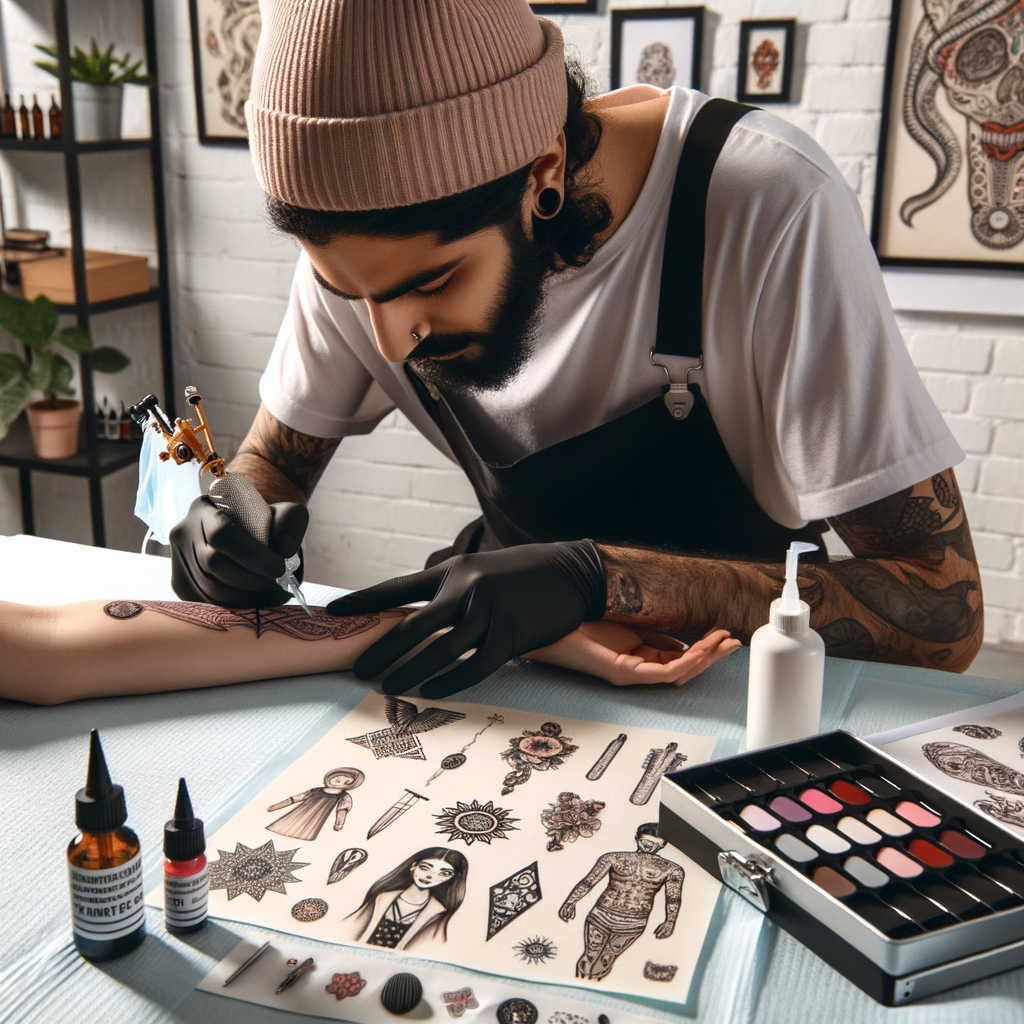
Introduction to Stick and Poke Tattoos
Stick and poke tattoos, also known as hand-poked tattoos, are a unique form of body art that has been gaining popularity in recent years. This blog post will provide an introduction to stick and poke tattoos, including their definition, history, and the growing popularity of DIY tattoos.
-
- Definition of Stick and Poke Tattoos
Stick and poke tattoos are a type of tattooing technique where ink is manually inserted into the skin using a single needle, rather than a tattoo gun. This method is often used for DIY tattoos because it requires less equipment and can be done at home. However, it’s important to note that while stick and poke tattoos can be a fun and creative form of self-expression, they also carry risks and should be done with caution.
-
- History and Origin of Stick and Poke Tattoos
The practice of stick and poke tattooing has a long and rich history. It is believed to have originated from ancient tribal cultures, where it was used as a form of ritual and identity marker. Over time, the technique has evolved and been adopted by various cultures around the world. In recent years, stick and poke tattoos have seen a resurgence in popularity, particularly among young people and artists looking for a more personal and hands-on approach to tattooing.
-
- Popularity of DIY Tattoos
DIY tattoos, particularly stick and poke tattoos, have become increasingly popular in recent years. This is largely due to the rise of social media platforms like Instagram and Pinterest, where users share their DIY tattoo designs and experiences. Additionally, the DIY approach allows for a more personal and unique tattoo experience. However, it’s important to remember that tattooing at home carries risks, and it’s crucial to ensure proper safety measures are taken.
In the following sections, we will delve deeper into the world of stick and poke tattoos, exploring different techniques, safety considerations, tattoo care, and design inspiration. Whether you’re considering getting a stick and poke tattoo or simply curious about this unique form of body art, this blog post will provide you with a comprehensive overview.
Understanding Hand Poked Tattoos
Hand poked tattoos, also known as stick and poke tattoos, are a unique form of body art. Unlike traditional machine tattoos, they are created by manually poking the skin with a needle dipped in ink. Let’s delve deeper into the process of creating hand poked tattoos and understand how they differ from machine tattoos.
-
- Process of Creating Hand Poked Tattoos
The process of creating hand poked tattoos is quite simple yet requires precision and patience. The artist first sketches the design on the skin with a stencil. Then, they dip a single needle in tattoo ink and manually poke it into the skin, dot by dot, to create the design. This process is repeated until the entire tattoo is complete. It’s a time-consuming process, but many people find it more personal and less painful than machine tattoos.
-
- Difference between Hand Poked Tattoos and Machine Tattoos
Hand poked tattoos and machine tattoos differ in several ways. The most notable difference is the method of application. While machine tattoos use an electric device to rapidly insert ink into the skin, hand poked tattoos are created manually, dot by dot. This results in a unique, handcrafted look that many people appreciate.
Another difference is the level of pain. Many people report that hand poked tattoos are less painful than machine tattoos. This is because the needle doesn’t go as deep into the skin, and there’s no electric buzzing noise, which can be unsettling for some.
Finally, hand poked tattoos tend to heal faster than machine tattoos. This is because they cause less trauma to the skin. However, they may require more touch-ups over time, as the ink doesn’t go as deep into the skin.
In conclusion, hand poked tattoos offer a unique, personal, and less painful alternative to traditional machine tattoos. Whether you prefer one method over the other depends on your personal preferences and pain tolerance.
Tattooing Techniques: Stick and Poke Method
One of the most popular tattooing techniques today is the Stick and Poke method. This method, also known as hand-poked tattooing, is a traditional way of creating tattoos. It involves using a needle to manually poke ink into the skin, creating a design. This technique is loved for its simplicity and the unique, artisanal results it produces.
Materials Needed
Before you start, it’s important to gather all the necessary materials. This ensures a smooth process and reduces the risk of interruptions or mistakes. Here are the key items you will need:
- Stick and Poke Tattoo Kit: This kit contains all the essentials for a safe and successful stick and poke tattoo. It usually includes professional tattoo needles, skin preparation materials, stencil paper, and more. These kits are designed to provide a safe and sterile environment for your tattooing process.
- Stick and Poke Tattoo Ink: This is a special type of ink designed specifically for stick and poke tattoos. It’s important to use this kind of ink to ensure the best results and safety. Regular ink is not suitable for tattooing as it can cause skin irritations or infections.
Remember, safety should always be your top priority when tattooing. Always use new, sterile materials and follow all safety guidelines to ensure a safe and successful tattooing experience.
Step-by-Step Process
-
- Preparing the Skin
Before you start with the stick and poke tattoo, it’s important to prepare your skin. This is a crucial step that ensures the tattooing process goes smoothly. Start by cleaning the area of your skin where you plan to apply the tattoo. Use a mild soap and warm water to remove any dirt or oils. After cleaning, pat the skin dry with a clean towel. Next, apply a small amount of tattoo stencil solution to the skin. This helps the design stick to your skin during the tattooing process.
-
- Drawing the Design
Once your skin is prepared, it’s time to draw your design. You can use a tattoo stencil to trace the design onto your skin. If you’re confident in your drawing skills, you can also freehand the design. Remember, it’s important to keep the design simple, especially if you’re a beginner. Complex designs can be difficult to tattoo and may not turn out as expected.
-
- Applying the Tattoo
Now, you’re ready to start the tattooing process. Dip your needle into the tattoo ink and then poke it into your skin. Be sure to poke the needle deep enough to reach the second layer of skin, but not so deep that it causes unnecessary pain or bleeding. Continue this process until you’ve completed the entire design. Remember to take your time and be patient. Stick and poke tattoos can take a while to complete, but the end result is worth it.
-
- Aftercare
After you’ve finished applying the tattoo, it’s important to take care of your skin to ensure the tattoo heals properly. Clean the tattooed area with warm water and mild soap, then pat it dry with a clean towel. Apply a thin layer of tattoo aftercare ointment to the tattoo. This helps prevent infection and keeps the tattoo looking fresh. Avoid scratching or picking at the tattoo as it heals, as this can cause damage.
Homemade Tattoos: Safety Considerations
When it comes to homemade tattoos, safety should always be your top priority. It’s easy to get caught up in the excitement and creativity of the process, but without proper safety measures, you could be putting your health at risk. Let’s explore some important safety considerations.
-
- Importance of Using Sterile Equipment
Using sterile equipment is crucial when creating a homemade tattoo. Any tools that come into contact with your skin should be thoroughly cleaned and sterilized to prevent infection. This includes needles, ink, and even your hands. According to the American Academy of Dermatology, using non-sterile equipment can lead to serious skin infections and diseases like Hepatitis B and C, and HIV.
-
- Risks Associated with DIY Tattoos
DIY tattoos come with a number of risks. These can range from minor skin irritations to more serious complications like allergic reactions, scarring, and even bloodborne diseases. It’s also worth noting that homemade tattoos are often more painful than those done by professionals, as they lack the precision and control of a professional tattoo machine.
-
- How to Ensure Stick and Poke Tattoo Safety
Ensuring safety when doing a stick and poke tattoo involves several steps. First, make sure your work area is clean and free of any potential contaminants. Second, always use new, sterile needles and high-quality tattoo ink. Never reuse needles or share them with others. Lastly, take your time. Rushing can lead to mistakes and increase the risk of injury or infection.
In conclusion, while homemade tattoos can be a fun and creative endeavor, they should never be undertaken lightly. Always prioritize your safety and health above all else. Remember, a tattoo is permanent, so it’s worth taking the time to do it right.
Stick and Poke Tattoo Care
After getting a stick and poke tattoo, it’s crucial to take care of it properly. This not only ensures the tattoo heals well but also maintains its appearance for a long time. Here are some important steps to follow for immediate and long-term care, as well as signs of infection to watch out for.
-
Immediate Aftercare
Once your tattoo is done, the artist will cover it with a bandage. Leave this on for at least two hours to protect the area. After removing the bandage, gently wash the tattoo with warm water and mild soap. Pat it dry with a clean towel and apply a thin layer of unscented moisturizer. Avoid touching the tattoo with dirty hands and keep it out of the sun.
-
Long-term Care
For the first few weeks, continue to wash your tattoo daily and apply moisturizer. Avoid swimming and soaking in water. As the tattoo heals, it will start to peel, similar to a sunburn. Do not pick at it or scratch it. After it’s fully healed, keep it protected from the sun to prevent fading. A stick and poke tattoo can last a lifetime with proper care.
-
Signs of Infection to Watch Out For
While infections are rare with professional stick and poke tattoos, it’s important to be aware of the signs. These include severe redness, swelling, pain, pus, or a fever. If you notice any of these symptoms, seek medical attention immediately. Remember, it’s better to be safe than sorry when it comes to your health.
In conclusion, taking care of your stick and poke tattoo is a straightforward process. With proper immediate and long-term care, your tattoo can remain vibrant and beautiful for many years. Always be vigilant for signs of infection and don’t hesitate to seek medical help if needed.
Exploring Stick and Poke Tattoo Designs
When it comes to stick and poke tattoos, the design possibilities are endless. From simple, minimalist designs to intricate, detailed artwork, there’s a stick and poke tattoo design out there for everyone. In this section, we will delve into the world of stick and poke tattoo designs, exploring popular designs and providing tips on how to choose the right design for you.
-
Popular Designs for Stick and Poke Tattoos
Stick and poke tattoos are known for their simplicity and rawness. Popular designs often include:
- Geometric Shapes: Circles, triangles, and squares are common choices for their simplicity and versatility.
- Nature-inspired Designs: Flowers, trees, and animals are often chosen for their beauty and symbolic meanings.
- Minimalist Art: Simple lines and dots can create powerful imagery with a minimalist approach.
Remember, the beauty of stick and poke tattoos lies in their simplicity. Even the most basic designs can make a big impact.
-
Choosing the Right Design for You
Choosing the right design for your stick and poke tattoo can be a personal journey. Here are a few tips to guide you:
- Consider Your Interests: Choose a design that reflects something you love or are passionate about.
- Think About Placement: The location of your tattoo can influence the design. Smaller, simpler designs work well for smaller areas.
- Reflect on the Meaning: Many people choose designs that have a personal or symbolic meaning to them.
Ultimately, the right design for you is one that you will be happy with for years to come. Take your time, do your research, and choose a design that speaks to you.
Exploring stick and poke tattoo designs is an exciting part of the tattooing process. Whether you opt for a popular design or create something uniquely yours, remember that the most important thing is that your tattoo represents you.
Case Studies: Successful Stick and Poke Tattoos
Let’s explore some real-life examples of successful stick and poke tattoos. These case studies will show you the potential of this unique tattooing technique.
-
Case Study 1: Simple Design, Big Impact
Our first case study involves a young woman named Lisa. Lisa wanted a small, simple design that held a lot of personal meaning. She chose a small heart on her wrist – a tribute to her late grandmother who always wore a heart-shaped locket.
Using the stick and poke method, Lisa was able to achieve a clean, minimalist design that was exactly what she wanted. The tattoo healed well, and Lisa followed all the necessary aftercare steps to ensure its longevity.
Despite its simplicity, Lisa’s tattoo has a big impact. It’s a daily reminder of her grandmother and the love they shared. This case study shows that stick and poke tattoos can be simple yet powerful expressions of personal meaning.
-
Case Study 2: Overcoming Challenges with DIY Tattoos
Our second case study features a man named Tom. Tom had always been interested in DIY projects and decided to try his hand at a stick and poke tattoo. He wanted to create a small anchor on his ankle to symbolize his love for sailing.
Tom faced several challenges during the process. He found it difficult to maintain a steady hand and struggled with getting the depth of the needle just right. However, with patience and practice, Tom was able to overcome these challenges and create a tattoo he’s proud of.
This case study illustrates that while DIY stick and poke tattoos can be challenging, they’re not impossible. With patience, practice, and a commitment to safety, you can create a meaningful piece of body art.
These case studies demonstrate the versatility and potential of stick and poke tattoos. Whether you’re looking for a simple design with deep personal meaning or you’re eager to tackle a DIY project, stick and poke tattoos offer a unique and rewarding experience.
Conclusion: The Art and Appeal of Stick and Poke Tattoos
As we draw to the end of our exploration of stick and poke tattoos, we can appreciate the artistry and unique appeal that this tattooing technique offers. It’s a method that combines simplicity, creativity, and a touch of the unconventional, making it a popular choice for many tattoo enthusiasts.
-
- Key Takeaways
Throughout this article, we’ve delved into the world of stick and poke tattoos, providing insights into their history, techniques, safety considerations, and aftercare. We’ve also explored a variety of designs and shared some successful examples of this art form.
Some key points to remember are:
-
-
- Stick and poke tattoos are a form of body art that involves using a needle to manually insert ink into the skin.
- While they can be done at home, it’s crucial to understand the safety risks and necessary precautions to avoid infection and ensure a good result.
- Proper aftercare is essential to maintain the quality and longevity of your tattoo.
- There’s a wide range of designs available, from simple geometric shapes to intricate illustrations, allowing for personal expression and creativity.
- Future of Stick and Poke Tattoos
-
As for the future of stick and poke tattoos, it’s clear that this art form is here to stay. Its appeal lies in its simplicity and the personal touch that comes from a handcrafted tattoo. With more people seeking unique and meaningful body art, we can expect to see continued growth and innovation in this field.
Moreover, as safety measures and tattooing techniques continue to evolve, stick and poke tattoos will become even more accessible and appealing to a broader audience. Whether you’re an experienced tattoo enthusiast or a curious beginner, there’s no denying the charm and allure of this timeless art form.






